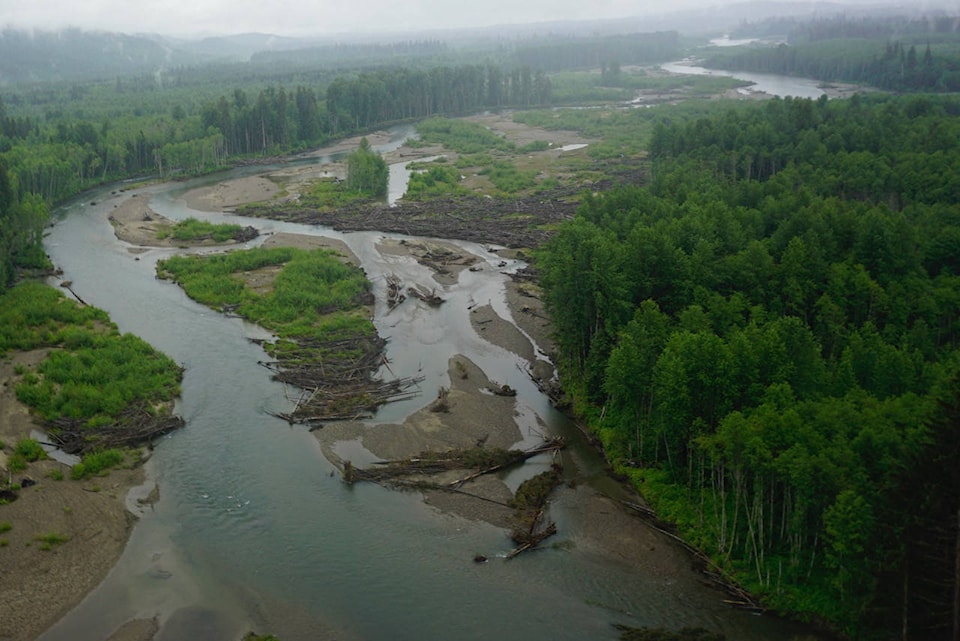In the wake of the one-year anniversary of Nick Hopwood’s drowning on the Kitimat River, Kitimat Search and Rescue has partnered with two local fishing guides to come up with a number of Kitimat River Safety Initiatives to prevent further drownings and help people stay safe while out fishing.
Kitimat Search and Rescue (KSAR) Search Manager Kelly Marsh said that river safety is an issue they’ve been trying to draw attention to so they can begin working with the public to fix it.
RELATED: Deadly logjam still poses a threat to boaters, anglers
“We really noticed that there was a real lack of people wearing PFDs, personal floatation devices, and lifejackets while floating on the Kitimat River,” Marsh said. “In the last two drownings on the river, lifejackets would’ve made a difference”
After the drowning of an Alberta man in 2018, KSAR, along with several other groups such as the Kitimat RCMP, Fire Services, and the District of Kitimat, put their heads together to come up with an action plan moving forward. This resulted in the Kitimat River Updates Facebook page, where people can contribute river information and safety tips for others.
However, on June 8, 2019, 21-year-old Nick Hopwood drowned in the river.
“You have no idea how brutal it is seeing those words beside the name of someone you love,” Hopwood’s sister Ashleigh wrote in a Facebook post on the one-year anniversary of the event.
“You see and hear about the most awful tragedies…” Ashleigh wrote in another post, “you never ever think it will happen to you or your family.”
Shortly after Hopwood’s drowning, his stepfather Dave Pendrey and mother Jill Pendrey approached KSAR to see how they could help. KSAR said they needed funds so they could reestablish the Kitimat Swiftwater Rescue Team, and with a fundraiser, a GoFundMe, and a $40,000 donation from LNG Canada, they managed to raise $90,000 total for the project.
While this was great for reactive measures, Marsh said they felt they needed more on the education side, especially for PFD and waders usage. KSAR, together with Hopwood’s stepfather, mother, and sister, came up with the acronym “N.I.C.K” (as seen in photo) to provide those going out fishing with a meaningful way to remember ways to be safe while out on the water.
KSAR also partnered with two local fishing guides, Ron Wakita and Tracey Hittel, which will allow the guides and their clients to promote PFD usage to others while they’re on the river.
“[KSAR has] talked to people on the river, and a lot of times we feel like we’re brushed off,” Marsh said, “but we thought getting some guides on board was key, because they’re the professionals on the river. They set the example, and will set the example, but it’s up to other people to follow.”
Wakita said he thinks it’s very important what Marsh and the others are doing and he had no hesitation when asked to get involved.
“I was born and raised here. I have two boys, two girls, and three grandchildren, and they all have friends, and [fishing and boating safety are] really important,” Wakita said. “Nobody should go fishing and then not come home.”
RELATED: Tragedy highlights the need for safety equipment
Currently, the rule for those on the water is that there must be one PFD per person onboard the boat, but they don’t have to be on your person. Marsh said the compliance rate of those who use their PFD is well below 50 per cent, as well.
“We all want to enjoy the fishing experience, but come home at the end of the day,” Marsh said. “A PFD is not going to save you every time, it depends on the circumstances. But it will give you a fighting chance, and in the worst case scenario, it will help us bring you back to your family.”
Marsh said he wants people to remember to talk to local outfitters, fishing stores, and locals, or hire a guide if you haven’t been on the river before. As well, he said if you get out on the river and don’t know what’s around a corner, it’s good to get out and walk around to see what’s there instead of taking the corner in your boat.
As well, locally, Marsh said the lower section of the river from Cable Car down to Haisla Bridge is generally safer than the upper section, but to try to wear a PFD no matter where you are on the water, for your sake as well as your family’s.
“The hydraulic power of water is no match for a human,” Marsh said. “If the worst case happens, it’s tragic that someone loses their life, but it’s another tragedy what happens to the family afterwards.”

